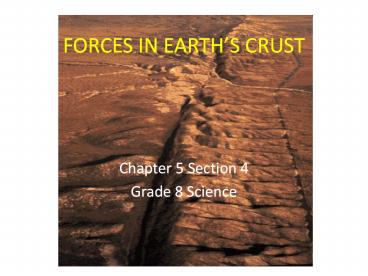FORCES IN EARTH - PowerPoint PPT Presentation
1 / 17
Title:
FORCES IN EARTH
Description:
FORCES IN EARTH S CRUST ... Faults are breaks in the crust where rock surfaces slip past each other. ... Compression can form folded mountains in the middle of a ... – PowerPoint PPT presentation
Number of Views:135
Avg rating:3.0/5.0
Title: FORCES IN EARTH
1
FORCES IN EARTHS CRUST
- Chapter 5 Section 4
- Grade 8 Science
2
FORCES IN EARTHS CRUST Key Concepts of CH 2
Section 1
- How does stress in the crust change Earths
surface? - Where are faults usually found, and why do they
form? - What land features result from the forces of
plate movement?
3
What does stress look like?
- A teacher under stress!
- Earths crust under stress!
4
What is stress?
- Stress is a force
- Stress acts on rock to change its shape or volume
- Deformation of rock occurs (de- undo form-
shape/appearance) - Examples of stress are TENSION, COMPRESSION, and
SHEARING - Stress adds energy to the rock
- Energy is released when rock changes shape or
breaks (ex. Such as during an earthquake!)
5
Diagram of Stress in Earths Crust
6
Comparing Types of Stress
Type of Stress Direction of movement Effect on crust
TENSION PULLS CRUST APART STRETCHES ROCK-BECOMES THINNER
COMPRESSION PUSHES CRUST TOGETHER SQUEEZE COMPACTS ROCK
SHEARING PUSHES IN OPPOSITE DIRECTIONS ROCK BREAKS, TWISTS, OR CHANGES SHAPE
7
TENSION
- Forces in Earths Crust
- The stress force called tension pulls on the
crust, stretching rock so that it becomes thinner
in the middle.
8
COMPRESSION
- Forces in Earths Crust
- The stress force called compression squeezes rock
until it folds or breaks.
9
SHEARING
- Forces in Earths Crust
- Stress that pushes a mass of rock in two opposite
directions is called shearing.
10
Where does stress come from?
- The movement of Earths plates creates enormous
stress that squeezes or pulls rock in the crust. - Since plates move slowly, changes in Earths
crust also occur slowly. - Over millions of years, stress will cause crust
to bend, stretch, break, tilt, fold, slide.
11
Folding Faulting
- Folding occurs as rocks bend slowly, like road
tar softened by the sun. - Folding is caused mainly by compression.
- Folds are bends in rock that form when
compression shortens and thickens the crust.
- Faulting occurs when rocks break
- Faulting is caused by extreme stress- tension,
compression, or shearing. - Faults are breaks in the crust where rock
surfaces slip past each other.
12
How folding changes Earths surface
- Folding of rock is caused by compression forces
as one plate pushes against another plate
?squish!? - Compression makes parts of crust shorter and
thicker. - Folds can bend upward like an arch (anticline),
or downward like a valley (syncline). - Compression can form folded mountains in the
middle of a continent (like Appalachians) or at
the edges of a convergent boundary (like
Himalayas and Alps)
13
Folded Mountains- in the middle of a continental
plate
Appalachian Mountain Range, USA
14
Folded Mountains- at convergent plate boundary
Himalayas Mountain Range, Nepal
15
How faulting changes Earths surface
- When enough stress builds up in rock, it breaks,
creating a fault. - Rocks on either side of a fault move up, down, or
sideways - Most faults occur along plate boundaries, but can
be found anywhere stress builds up in the crust
(ex. There are small faults in central Oklahoma,
this is why they had EQ activity recently!) - Three kinds of faults normal, reverse,
strike-slip- each differs in the direction rock
moves on either side of fault - Movement along a fault usually results in seismic
activity. earthquakes!!!
16
Comparing FAULTS
Type of Fault Stress Effect on crust
NORMAL Tension Pulls rock apart- up/down motion (forms at divergent boundaries
REVERSE Compression Pushes rock together- down/up motion
STRIKE-SLIP Shearing Plates move past each other- sideways motion (transform boundaries)
17
Your task Show your understanding of forces in
Earths crust using various forms of graphic
organizers.
- Complete Chart for types of stress. Use
information from the slides textbook. - Fill in a Venn Diagram comparing Folding
Faulting. You should include AT LEAST 3
similarities and differences- be specific! - Compile all of the material in an original
acrostic using the word STRESS. For each
letter, write a descriptive sentence. Add at
least 1 colored drawing that shows an important
fact about stress.































